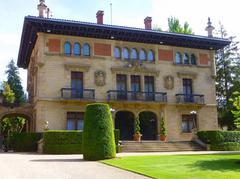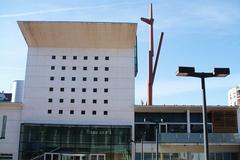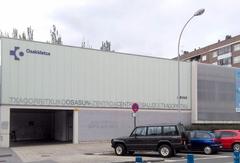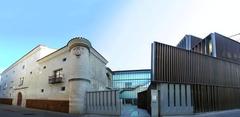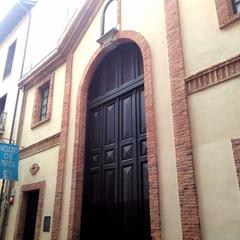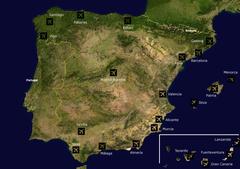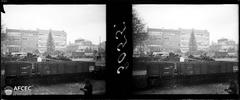Visiting the Cemetery of Santa Isabel, Vitoria-Gasteiz, Spain: A Complete Guide to Tickets, Hours, and Tips
Date: 15/06/2025
Introduction
The Cemetery of Santa Isabel in Vitoria-Gasteiz is more than a burial site—it is a living testament to the city’s layered history, artistic achievements, and enduring social traditions. Established in 1808, Santa Isabel is one of the Basque Country’s most significant necropolises, renowned for its blend of neoclassical, neo-Egyptian, and modernist architecture, as well as its remarkable funerary art and symbolic sculptures. As the final resting place of notable figures such as Sebastián Iradier Salaberri and General Miguel Ricardo de Álava, the cemetery also serves as an open-air museum, attracting history buffs, art lovers, and cultural tourists alike.
This comprehensive guide offers detailed insights into the cemetery’s origins, architectural evolution, notable burials, and the symbolic language embedded in its monuments. It also provides essential visitor information, including opening hours, ticketing, accessibility, transportation options, and practical tips to enhance your experience. Whether you are seeking a tranquil place for reflection, a journey through history, or inspiration from unique artistry, the Cemetery of Santa Isabel promises an enriching visit.
For up-to-date information and to book guided tours, consult the official tourism resources (lomejordelpaisvasco.com).
Table of Contents
- Origins and Early Development
- Expansion and Architectural Evolution
- Notable Figures and Historical Personalities
- Funerary Art and Symbolism
- Cultural and Historical Significance
- Practical Visitor Information
- Cultural Impact and Community Traditions
- Legends, Mysteries, and Popular Culture
- Environmental Considerations
- Nearby Attractions
- Frequently Asked Questions (FAQ)
- Conclusion and Recommendations
- References
Origins and Early Development
The Cemetery of Santa Isabel was established in the early 19th century against a backdrop of social and political transformation in Spain. Construction began in 1804 on land adjacent to the hermitage of Santa Isabel and, by 1808, the site was consecrated as the city’s main burial ground (lomejordelpaisvasco.com). Before its founding, burials were scattered throughout Vitoria-Gasteiz, often in makeshift cemeteries on Calle Fueros and San Prudencio. Archaeological finds, including the remains of French soldiers from the late 18th-century War of the Convention, highlight the city’s historical significance as a strategic military site. A stone cross from 1795, once located on Calle Fueros, now stands at Santa Isabel, symbolically linking past and present.
Expansion and Architectural Evolution
Responding to population growth and changing burial customs, Santa Isabel expanded several times—in 1848, 1854, 1875, 1907, 1924, and 1958. Today, the cemetery spans over 57,000 square meters, making it one of the largest and most artistically significant cemeteries in the Basque Country. The grounds showcase a harmonious blend of neoclassical, neo-Egyptian, eclectic, and modernist styles. Mausoleums and pantheons designed by acclaimed architects and sculptors reflect the tastes of Vitoria-Gasteiz’s elite, while also serving as a testament to the city’s evolving artistic sensibilities (lamuerteossientatanbien.com).
Notable Figures and Historical Personalities
Santa Isabel is the final resting place for a host of influential figures:
- Sebastián Iradier Salaberri: Internationally renowned composer.
- General Miguel Ricardo de Álava: Prominent military leader and diplomat.
- Dámaso Villanueva Trocóniz: Republican politician, industrialist, and writer.
- Elvira Arias de Apraiz: Celebrated poet and author.
- Julián de Zulueta: Noted for both his wealth and the legendary angel on his tomb.
Other prominent burials include Micaela Portilla, Quintín Ruiz de Gauna, Ricardo Buesa, and Vicente Goikoetxea. The cemetery also contains the graves of ordinary citizens, whose collective stories make Santa Isabel a social chronicle of Vitoria-Gasteiz.
Funerary Art and Symbolism
Santa Isabel is celebrated for its funerary art and rich symbolic language:
- Architectural Styles: Neoclassical symmetry, neo-Egyptian motifs (sphinxes, obelisks), and eclectic influences are evident. Family crests, ironwork, and stained glass are common in mausoleums.
- Sculptural Details: Expressive angels, weeping figures, and allegories of virtues like Faith and Hope adorn many monuments. The most iconic is the angel atop Julián Zulueta’s vault, said in local legend to point to the next visitor to be claimed by death (vitoria-gasteiz.org).
- Landscaping: Mature cypress and yew trees symbolize mourning and eternal life. Ivy climbing the tombs represents immortality.
- Religious and Civil Monuments: The main chapel features stained glass depicting the life of Christ, and there are memorials to civil war victims and epidemic casualties.
Cultural and Historical Significance
Santa Isabel is not just a cemetery but a living heritage site. Its necrological, historical, and botanical value has made it a focal point for cemetery tourism—a growing trend in Europe. Guided tours, often led by local historians, bring the stories of the interred and the cemetery’s art to life. The cemetery also reflects changing attitudes toward religious diversity, with a section dedicated to non-Catholic burials established in 1835 (gasteizhoy.com).
Practical Visitor Information
Location and Access
- Address: Arriagako Atea Kalea, 26 A, Vitoria-Gasteiz.
- Access: Easily reached by bus (lines 1, 2, 4), car, taxi, or a 25-minute walk from the city center. Parking is available nearby but limited (todosloscementerios.com).
Visiting Hours
- April – October: 9:00 AM to 8:00 PM
- November – March: 9:00 AM to 7:00 PM
- Note: Hours may vary on public holidays; check before visiting.
Tickets
- Free Entry: No ticket required for general visits.
- Guided Tours: Highly recommended for an in-depth experience; book in advance via the official website or tourism office. Some tours are thematic or theatrical.
Accessibility
- Wheelchair Access: Main pathways are paved, with ramps and assistance available upon request.
- Restrooms and Water Fountains: Located near the entrance.
- Information Boards: Maps and historical context are displayed at key points.
Facilities and Services
- Florist: Fresh flowers available on-site.
- Gardening Services: Maintenance for plots and communal areas.
- Photography: Permitted for personal use; commercial photography requires permission.
Visitor Etiquette
- Speak quietly and avoid disruptive behavior.
- Stay on designated paths and avoid walking over graves.
- Respect ongoing funerals and ceremonies.
- Supervise children and avoid eating, drinking, or smoking within the grounds.
Cultural Impact and Community Traditions
Santa Isabel holds a central place in Vitoria-Gasteiz’s community life. All Saints’ Day (November 1st) transforms the cemetery into a vibrant hub as families honor their ancestors with flowers and candles (gasteizhoy.com). Throughout the year, the cemetery hosts educational tours, art walks, and commemorative events, underscoring its status as both a site of memory and ongoing community engagement.
Legends, Mysteries, and Popular Culture
The cemetery’s evocative setting and sculptural wealth have inspired local legends. The most famous is the tale of the angel on Julián Zulueta’s tomb, whose hand supposedly points out the next visitor to die (vitoria-gasteiz.org). Santa Isabel is featured in “City of Mystery” tours and cultural festivals that celebrate both history and folklore.
Environmental Considerations
Santa Isabel Cemetery upholds high standards of environmental stewardship, in line with Vitoria-Gasteiz’s reputation as a European Green Capital. Visitors are encouraged to respect local flora, avoid littering, and follow guidelines that help preserve the site’s natural and built heritage (koragreencity.com).
Nearby Attractions
Combine your cemetery visit with other highlights in Vitoria-Gasteiz:
- Florida Park: A historic botanical garden ideal for a relaxing stroll (koragreencity.com).
- Old Town (Casco Medieval): With landmarks like Santa María Cathedral, pintxos bars, and charming plazas (unstoppablestaceytravel.com).
- Plaza de la Virgen Blanca: The city’s iconic square.
- Artium Museum: For modern and contemporary art exhibitions.
Frequently Asked Questions (FAQ)
Q: What are the visiting hours for Santa Isabel Cemetery?
A: April–October: 9:00 AM–8:00 PM; November–March: 9:00 AM–7:00 PM. Hours may vary on holidays.
Q: Is there an entrance fee or ticket required?
A: No. Entry is free; guided tours may require advance booking and a fee.
Q: Is the cemetery wheelchair accessible?
A: Yes; main paths are paved, with ramps and assistance available. Some older sections may be uneven.
Q: Are guided tours offered?
A: Yes, especially during cultural events and All Saints’ Day. Booking in advance is strongly recommended.
Q: Can I take photographs?
A: Yes, for personal use. Commercial photography requires prior authorization.
Q: What is the best time to visit?
A: Mornings or late afternoons on weekdays offer optimal lighting and fewer crowds.
Q: Are there special events at the cemetery?
A: Yes, including guided tours, art walks, and All Saints’ Day celebrations.
Conclusion and Recommendations
The Cemetery of Santa Isabel is more than a final resting place—it is a dynamic repository of Vitoria-Gasteiz’s artistic, historical, and communal legacy. Its serene atmosphere, monumental art, and connection to local traditions make it an essential stop for anyone interested in the Basque Country’s heritage. For the most rewarding visit, plan to join a guided tour, explore related cultural sites nearby, and use resources like the Audiala app for audio guides.
For official hours, guided tour bookings, and further visitor information, consult the official resources (lomejordelpaisvasco.com) and the Vitoria-Gasteiz tourism office.
References
- Visiting the Cemetery of Santa Isabel in Vitoria-Gasteiz: History, Tours, and Visitor Information (lomejordelpaisvasco.com)
- Visiting the Cemetery of Santa Isabel in Vitoria-Gasteiz: History, Art, and Visitor Information (lamuerteossientatanbien.com)
- Santa Isabel Cemetery Vitoria-Gasteiz: Visiting Hours, Tickets & Historical Sites Guide (todosloscementerios.com)
- Visiting the Cemetery of Santa Isabel in Vitoria-Gasteiz: History, Art, and Visitor Information (vitoria-gasteiz.org)
- Santa Isabel Cemetery Vitoria-Gasteiz: Visiting Hours, Tickets & Historical Sites Guide (koragreencity.com)
- Things to Do in Vitoria-Gasteiz: Attractions (unstoppablestaceytravel.com)
Image suggestions:
- Entrance of Santa Isabel Cemetery, highlighting neoclassical architecture (alt: “Santa Isabel Cemetery Vitoria-Gasteiz entrance showcasing historic architecture and signage”)
- Close-up of the angel statue on Julián Zulueta’s tomb (alt: “Angel statue on Julián Zulueta’s tomb at Cemetery of Santa Isabel”)
- Aerial view of the cemetery’s layout (alt: “Aerial view of Cemetery of Santa Isabel in Vitoria-Gasteiz”)
- Visitors during All Saints’ Day (alt: “Families visiting Cemetery of Santa Isabel during All Saints’ Day in Vitoria-Gasteiz”)
Internal links for enhanced navigation:
